We so often watch the top German riders working on the Grand Prix movements that it comes as something of a shock to see Klaus Balkenhol’s head rider, Stefan Wolff, working with a very very green three year old filly by Rubin Royal. Stefan has ridden her five times, but has recently been away, and she hasn’t been worked for the past two weeks.
Stefan is taking no chances, he gently lunges her around the arena, and while the little princess is all eyes and ears, she is mostly obedient. He then gets the other bereiter at the Klaus Balkenhol training stables, Jamie, to hold her while he checks out how she is going to relate to his weight, and then Jamie lunges the pair of them until it is time for Stefan to go for a little burn.
By this time the man they call ‘’chef’, master trainer Klaus Balkenhol, has wandered into the arena: “She was very spooky when we started with her,” he tells me.
“We like to start them at three, get the saddle on and ride forward –- no more. She must trust the arena, the people, the saddle, she must learn to trust everything. And we ride her like this for six months. We must look that she is very good in the rhythm, good in the balance. Rhythm and suppleness, that’s the first thing –- and suppleness in the brain. We just play with the horse for the first year, make it fun for the horse, but all the time we look to the balance of the horse, and I think you can see that with this one even though she is just started.”
Stefan is happy with the filly: “It’s just time. She is just scared and doesn’t know anything… just time.”
And there is no hurry at the Stal Balkenhol.
Later in the day we watch Stefan work a nine-year-old gelding by Rubinstein out of a half Thoroughbred mare. This is a seriously spooky horse, although Stefan tells us that he has settled down considerably. When he teaches, Mr Balkenhol is very often asking his students for voltes, and Stefan has been with him for the past three years, he knows the drill –- when the gelding gets a bit spooked, it is straight into a volte –- and then into some beautiful soft rhythmic passage.
Despite the spookiness, Stefan enjoys riding the horse: “He is fun to ride, often he wants too much and gets a little hot.”
But he must be a handful at a competition?
“It is alright if the arena has enough space, but in a tight indoor arena where you are very close to the audience, he is very different. I can do two things –- take him to more competitions so he gets used to it, but more importantly, get him more supple and on the aids then I can better relax him all through his muscles and I have a better chance of him keeping cool all the way through a competition.”
Back to the indoor and Stefan is working with a very big daughter of the famous Westfalien stallion, Weinberg –- in fact, the last daughter of the sire of Klaus’ Olympic star, Goldstern. She has been used as a brood mare so despite the fact that she is eight years old, she is still relatively uneducated. Outside in the round yard the day before she has shown huge movement, and under saddle she is impressive:
“See how she comes from behind,”” Mr Balkenhol stresses, “”That is the most important thing, not the front legs. Get the hind legs and the front end will come. Long and low, that’s what she needs, to stretch with the nose out –- with the short neck you will never get the horse over the back. Sometimes you see them do that with the horse at an auction –- up in front and the front legs come out and it is very spectacular but there is nothing behind.”
Now Klaus and Judith’s daughter, Annabelle is in the arena, riding an eight year old De Niro gelding: “With this horse, he had too much pressure on him when he was five years old, and he became really blocked in the back,” Klaus tells me. “He spent the summer in the paddock, just doing nothing, then he came into work with my daughter, and he is winning at M level. Next season they go S, then Grand Prix. Now he will work –- the horse must go from behind by himself.”
And work he does – some great trot, huge canter and lovely changes.
Out on the outside arena the American rider, Arlene Page is schooling her Danish gelding, Wild Thing by the Hanoverian stallion, Wanderer. ‘’Toni’ as she is known, has worked with Klaus before and figures that this time she has got the timing just about right in her run up to the World Cup final in Amsterdam:
“The first week you spend with Klaus, he is so cool and relaxed, just every now and then he throws an idea at you. The second week he starts to dig, and by the third week, it is full on. I figured four weeks should be perfect for Amsterdam.”
Sure enough, Arlene was the star of the Grand Prix in the World Cup in Amsterdam with a super 70+ score, and now Wild Thing comes into serious consideration for the US team at the WEG.
“I’ve had my horse three and a half years, he came from Denmark. I tried him just one time, that is exactly how it has been with every good horse I’ve had –- I just thought, I hope I can ride you well enough. He had just finished the World Championships for six year olds, where he had an ignominious finish. He had won the Scandinavian title but when he came to Verden he was really down and finished 12th or 13th… That didn’t bother me, his gaits are very good and clean.”
“He could do flying changes comfortably but he needed to be helped a lot, and he was beginning to feel what it was to collect a little bit, but he had no piaffe / passage.”
Arlene has worked with Klaus before:
“I have been very lucky, I had always produced horses that while they might not have been international quality horses, I was able to produce them well enough to be always on the USET developing list, so that meant every time Klaus was in the United States I was invited to the clinics, and I don’t need to tell you, he is a generous man.”
“Now that his time in the States is a little tight, he can only work with the really top riders, he feels he doesn’t have the time to work with possibly talented riders on normal horses. Thank god ten years ago, he was willing to do that, because I had pretty normal horses. But he always gave me time in his clinics and I learned many things from him. In 2001 I got a grant to come to his stables in Germany on my first really top horse, and stayed here for three months.”
“I can’t even begin to tell you how important that experience was in preparing me to come here and compete on another horse. You see his system, and you have confidence in it, and you kind of know where he is going with you.”
“The key things in his system are like this. One, there is no force. I’ve been here for months and months, and he is never rough. There are moments for sure, when you have to say to a horse, come, now is the time. But that is only done when it is fair. You can see even with my horse today, there’re a couple of times when Klaus says, ‘’come now’. He knows the pirouette, he understands what is happening, and you can teach him –- hey, the hindlegs have got to be quicker. I have confidence that Klaus will never go beyond the point of fairness with a horse. That for me is a key.”
“The other point is that it is absolutely consistent. Always the same things –- there are no fads. The horse has to be through the neck, through the back, in front of your leg, working . Taking the weight to his hind leg in the half halts, always listening. It is very simple, and it is always always the same. It is an environment that is very conducive to learning, building confidence and bringing out the best in the horses. The footing is good, his training is consistent. Judith, Klaus’ wife is lovely, she always makes you feel welcome.”
“The other thing that is very important, for me anyway, is that Klaus can put his money where his mouth is. He can get on and show you exactly what he is after. Or, he can ride your horse, then you get on and you feel what he meant. So you begin to see the possibilities, and I think that is very hard for riders, certainly hard for me, I’m no rocket scientist, so the abstract is not for me, but once I see it, it is like ‘’ah I see, you meant!’”
Getting Klaus to sit down long enough for an interview is always difficult, but at the end of the day, sitting by a cheery fire, he finds time to talk about his early riding experiences and the way his philosophy of training has developed…
“My love for horses started when I was still a kid. I grew up on the farm with a lot of animals, including horses. I always had fun riding –- I was riding everything that ran around, including the goats, the sheep, then the farm horses. I worked with those horses all day long, ploughing the field. In the evening when this was done, I went to the country-riding club, sports riding. I started with a little eventing, and I was lucky to have very good teachers there.”
“When you work every day with horses, and they are what you depend on for the money, then you have to take care of them and keep them healthy, and you build up a very good relationship with those horses. That’s how this all started.”
“When the whole agricultural business did not look so healthy, then I started thinking, what to do with my life to earn money. That’s when it was time for me to do my army service –- again, no money. But if you joined the police, then you didn’t have to do military service, and so there I was. It was hard at the beginning. I had worked from the age of 14 until 20 on the land, and then when I joined the police, I had to go back to school. Writing, mathematics, it was hard being a pupil again, and at that stage being in the police force was like being in the army.”
“After I finished my initial training, I was sent to the village where Judith my-wife-to-be lived. I was 24 then, and the first thing I did was look for a room. So I looked for a tractor because that meant a farm, and I stopped the guys driving it –- they were afraid they had done something wrong –- but I said no, I only want to find a room to stay. That is how I met Judith, I had a horse by the same stallion as her horse and we went to the same riding club.”
“Then I thought I could spend more time with horses if I went to the mounted police and I was very lucky there to have a very good instructor from the Hanoverian Riding School, Otto Hartwich, he had been a friend of Georg Wahl at the Riding School.”
And with the new ‘’modern’ horses, did you have to change those principles you learnt from Mr Hartwich?
“The horses haven’t really changed, the inside, the character of the horse, is almost always the same. Some are more sensitive, some you have to ask a little more. Perhaps they are easier today to ride, but that is the dangerous part because it still takes the same time to build up the muscles, but the new horses seem to be easier. I was talking with Paul Stecken, and he said to me that in former times, it would not have been possible to ride a horse like they do today, because the muscles in former times were not there –- but today they are there when the horse is three years old. They seem to have the muscles but they are still weak, they are still babies, they just look grown up.”
“I’ve tried to retain what I learnt from Otto Hartwich because I think it works for all horses; it is a training recipe that has been developed over the centuries. I find this is the way to make a horse sound and mentally happy. Obviously when you train a horse, there are problems and things don’t always go right. Goldstern was a very difficult horse and at times I would ride him behind the vertical –- but I know that the principles of Otto Hartwich are the right ones for every horse. But for these principles, you need time, and if you don’t have time, you shouldn’t ride.”
“Otto Hartwich was one of the very few riders in the Hanoverian Riding School who really understood the correct way of riding. He was a very modest man, very nice and friendly, and he wanted to help me because he felt I had some talent. He gave me a mare that was very nice, but when I got on her, no matter what I did, she had her neck up in the air! So Otto Hartwich got on that mare and threw the reins away, and sat, and away she went, fine. Then when I got on again, it was the same, for me she was hollow in the back, and up with the neck, when I sat up on her, she would not go through the back and the neck –- but when he sat, he sat in the horse, he combined the seat and the leg to create such power from behind through the bridge of the back. I stood there thinking to myself, what is that, what did he do? I need to learn that. I pleaded with him, tell me what you did. What is that? He said, ‘’you must look, I cannot explain the feel’. I looked and looked and looked again, and all the time I said to him, ‘’you sit again please?’ No he said, you must learn from the horse.”
“You must learn the language from the horse, that’s the first thing. The horse must understand you, you must talk to the horse through your aids: the voice, the seat, your legs, your hands. The horse must look first to the rider, and it is important that you speak the language of the horse. I worked with that horse, and eventually she was my best teacher. The horse would tell me, no, not that way, go another way. I was able to do it, I had the time.”
“There was a big horse in the school, and the assistant to Otto Hartwich, he always rode this horse, and after ten minutes the horse’s neck would go up up up from the aids, but when Otto Hartwich sat on the horse, and the horse’s back was up and the neck was out and down, it was unbelievable. When the rider understands what the horse knows, they are together in harmony. That is the first thing you have to work on with the horse – the horse must understand what you say, and you must listen to the horse.”
“When I get on a horse, first I look into him, what is he trying to say to me? Sometimes the horse is not right, so I would say, okay, back to the stable. The first thing is that the horse is okay, then you can work with him. That is what Otto Hartwich said all the time, you must really understand the horse.”
“We have in our barn a rider – Stefan – who has been with us a long time and this morning he was working on the piaffe and passage with the chestnut horse. He has been working with this horse for two years, and still today, I talked to him, and said ‘’Stefan use your back and give the rein, touch the horse a little with the leg, bring the horse forward, half halt and give.’ He had too much rein, but when he listened to me, and the horse came into balance, and he was so happy, he really felt it. You have to bring him back but then give and keep him with your seat.”
“I am always saying to the riders, give give give. But the problem is that the riders do not feel secure enough so they close the horse in front. That is wrong, you close the horse from behind, that is the first thing and give rein and the horse can go in front.”
It was time to leave and to once again thank Judith and Klaus for their time and hospitality, and for the opportunity to spend time in their wonderful training facility.
This article originally appeared in the October 2006 edition of The Horse Magazine



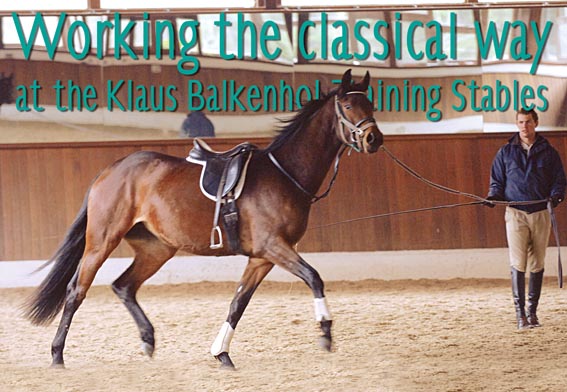

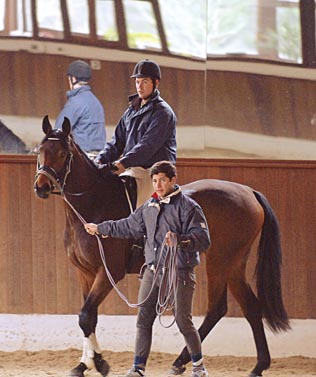


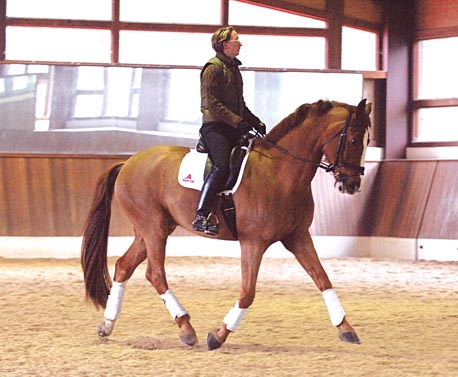
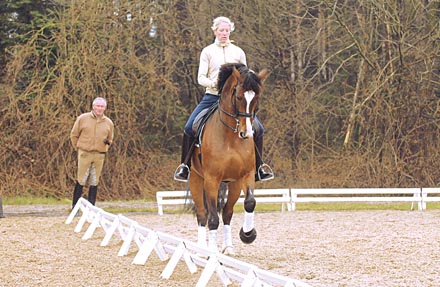
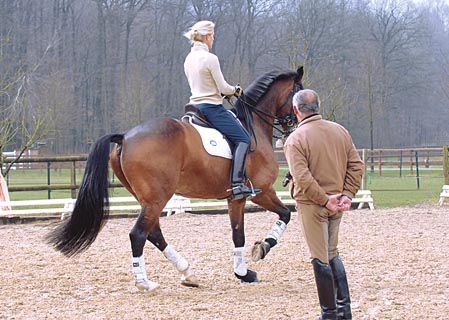
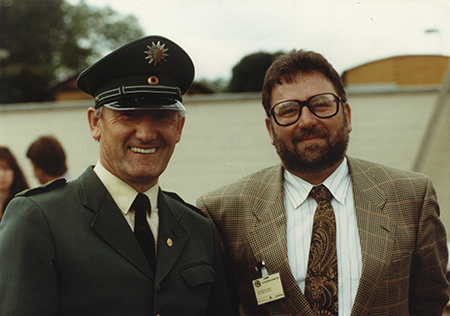
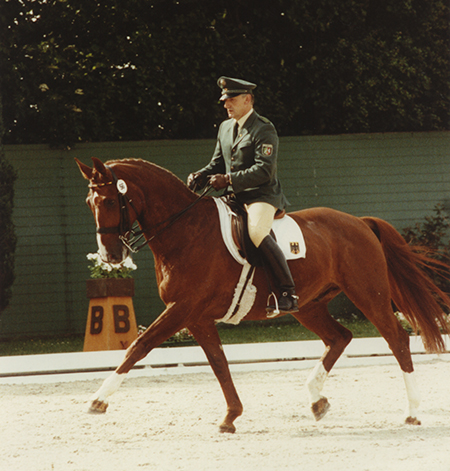
Great Article. Everyone should read it.
A really wonderful read